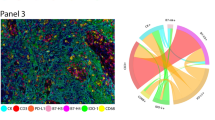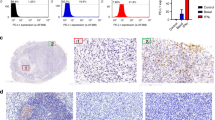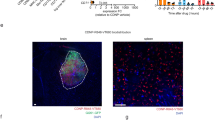Summary
This study describes the effects of the glucolipid synthase inhibitor P4, (DL-threo-1-phenyl-2-palmitoylamino-3-pyrrolidino-1-propanol), on various functional and phenotypic parameters of 5T33 murine myeloma cells. Cell recovery was reduced by >85% following incubation of the cells for 3 days in the presence of 4 μM P4 (the IC50 concentration). Both cytostatic and cytotoxic inhibition was observed with tumour cell metabolic activity and clonogenic potential reduced to 42% and 14% of controls, respectively, and viability reduced to 52%. A dose-dependent increase in cells undergoing apoptosis (from 7% to 26%) was also found. P4 induced a decrease in the number of cells expressing H-2 Class I and CD44, and a large increase in cells expressing H-2 Class II and the IgG2b paraprotein. It did not affect surface expression of CD45 or CD54 (ICAM-1). Based on these alterations in tumour cell growth, adhesion molecule expression and potential immunogenicity, it is anticipated that P4 will provide a novel therapeutic approach for the treatment of multiple myeloma. In addition, given that essentially all tumours rely heavily on overexpressed or abnormal glucosphingolipids for growth, development and metastasis, glucolipid synthase inhibitors may prove to be universally effective anti-cancer agents.
Similar content being viewed by others
Article PDF
Change history
16 November 2011
This paper was modified 12 months after initial publication to switch to Creative Commons licence terms, as noted at publication
References
Abe, A, Radin, NS, Shayman, JA, Wotring, LL, Zipkin, RE, Sivakumar, R, Ruggieri, JM, Carson, KG & Ganem, B (1995). Structural and stereochemical studies of potent inhibitors of glucosylceramide synthase and tumour cell growth. J Lipid Res 36: 611–621.
Abe, A, Radin, NS & Shayman, JA (1996). Induction of glucosylceramide synthase by synthase inhibitors and ceramide. Biochim Biophys Acta 1299: 333–341.
Armstrong, TD, Clements, VK, Martin, BK, Ting, JP-Y & Ostrand-Rosenberg, S (1997). Major histocompatibility complex Class II-transfected tumour cells present endogenous antigen and are potent inducers of tumour-specific immunity. Proc Natl Acad Sci USA 94: 6886–6891.
Aruffo, A, Stamenkovic, I, Melnick, M, Underhill, CB & Seed, B (1990). CD44 is the principal cell surface receptor for hyaluronate. Cell 61: 1303–1313.
Baskar, S, Glimcher, L, Nabavi, N, Jones, RT & Ostrand-Rosenberg, S (1995). Major histocompatibility complex Class II+, B7-1+ tumour cells are potent vaccines for stimulating tumour rejection in tumour bearing mice. J Exp Med 181: 619–629.
Cabrera, T, Ruiz-Cabello, F & Garrido, F (1995). Biological implications of HLA DR expression in tumours. Scand J Immunol 41: 398–406.
Cremer, FW, Kiel, K, Wallmeier, M, Goldschmidt, H & Moos, M (1997). A quantitative PCR assay for the detection of low amounts of malignant cells in multiple myeloma. Ann Oncol 8: 633–636.
Croese, JW, Vissinga, CS, Boersma, WJA & Radl, J (1991a). Immune regulation of mouse 5T2 multiple myeloma. I. Immune response to 5T2 MM idiotype. Neoplasma 38: 457–466.
Croese, JW, Van Den Enden-Vieveen, MHM & Radl, J (1991b). Immune regulation of mouse 5T2 multiple myeloma. II. Immunological treatment of 5T2 MM residual disease. Neoplasma 38: 467–474.
Dabadghao, S, Bergenbrant, S, Anton, D, Wen, H, Holm, G & Yi, Q (1998). Anti-idiotypic T-cell activation in MM induced by M-component fragments presented by dendritic cells. Br J Haematol 100: 647–654.
Greipp, R (1992). Advances in the diagnosis and management of myeloma. Semin Hematol 29: 24–45, 1992.
Hakomori, S (1986). Glycosphingolipids. Sci Am 254: 44–53.
Hakomori, S (1994). Role of gangliosides in tumour progression. Prog Brain Res 101: 241–250.
Hakomori, S (1996). Tumour malignancy defined by aberrant glycosylation and sphingo(glyco)lipid metabolism. Cancer Res 56: 5309–5318.
Ilangumaran, S, Briol, A & Hoessli, DC (1998). CD44 selectively associates with active Src family protein tyrosine kinases Lck & Fyn in GSL-rich plasma membrane domains of human peripheral blood lymphocytes. Blood 91: 3910–3908.
Inokuchi, J, Mason, I & Radin, NS (1987). Antitumor activity via inhibition of glucosphingolipid biosynthesis. Cancer Lett 38: 23–30.
Inokuchi, J, Jimbo, M, Momosaki, K, Shimeno, H, Nagamatsu, A & Radin, NS (1990). Inhibition of experimental metastasis of murine Lewis lung carcinoma by an inhibitor of glucosylceramide synthase and its possible mechanism of action. Cancer Res 50: 6731–6737.
Kannagi, R (1997). Carbohydrate-mediated cell adhesion involved in hematogenous metastasis of cancer. Glycoconjugate J 14: 577–584.
Karre, K (1993). Natural killer cells and the major histocompatibility complex Class I pathway of peptide presentation. Semin Immunol 5: 127–145.
Klinken, SP (1988). Erythroproliferation in vitro can be induced by abl, fes, src, ras, bas, raf, faf/myc, erb B and cbl oncogenes but not by myc, myb, and fos. Oncogene Res 3: 187–192.
Kwak, LW, Campbell, MJ, Czerwinski, DK, Hart, S, Miller, RA & Levy, R (1992). Induction of immune responses in patients with B-cell lymphoma against the surface-immunoglobulin idiotype expressed by their tumors. N Engl J Med 327: 1209–1215.
Kwak, LW, Taub, DD, Duffey, PL, Bensinger, WI, Bryant, EM, Reynolds, CW & Longo, DL (1995). Transfer of myeloma idiotype-specific immunity from an actively immunised marrow donor. Lancet 345: 1016–1020.
Lavie, Y, Cao, H, Bursten, SL, Giuliano, AE & Cabot, MC (1996). Accumulation of glucosylceramides in multi-drug resistant cancer cells. J Biol Chem 271: 19530–19536.
Li, R, Villacreses, N & Ladisch, S (1995). Human tumor gangliosides inhibit murine immune responses in vivo. Cancer Res 55: 211–214.
Manning, LS, Berger, JD, O’Donoghue, HL, Sheridan, G, Claringbold, PG & Turner, JH (1992). A model of multiple myeloma: culture of 5T33 murine myeloma cells and evaluation of tumorigenicity in the C57BL/KaLwRij mouse. Br J Cancer 66: 1088–1093.
Manning, LS, Chamberlain, NL, Leahy, MF & Cordingley, FT (1995). Assessment of the therapeutic potential of cytokines, cytotoxic drugs and effector cell populations for the treatment of multiple myeloma using the 5T33 murine myeloma model. Immunol Cell Biol 73: 326–332.
Mosmann, T (1983). Rapid colorimetric assay for cellular growth and survival: application to proliferation and cytotoxicity assays. J Immunol Meth 65: 55–63.
Nakagawa, R, Motoki, K, Ueno, H, Iijima, R, Nakamura, H, Kobayashi, E, Shimosaka, A & Koezuka, Y (1998). Treatment of hepatic metastasis of the colon26 adenocarcinoma with an anti-galactosylceramide, KRN7000. Cancer Res 58: 1202–1207.
Nudelman, E, Levery, SB, Kaizu, T & Hakomori, S (1986). Novel fucolipids of human adenocarcinoma: characterisation of the major Ley antigen of human carcinoma as trifucosylnonaosyl Ley glycolipid. J Biol Chem 261: 11247–11253.
Okada, T & Hawley, RG (1995). Adhesion molecules involved in binding of murine myeloma cells to bone marrow stromal elements. Int J Cancer 63: 823–830.
Olshefski, R & Ladisch, SJ (1998). Synthesis, shedding, and intercellular transfer of human medulloblastoma gangliosides: abrogation by a new inhibitor of GlcCer synthase. Neurochem 70: 467–472.
Radin, NS (1994). Rationales for cancer chemotherapy with PDMP, a specific inhibitor of glucosylceramide synthase. Mol Chem Neuropathol 21: 111–127.
Radin, NS & Inokuchi, J-I (1988). Glucosphingolipids as sites of action in the chemotherapy of cancer. Biochem Pharmacol 37: 2879–2889.
Radin, NS, Shayman, JA & Inokuchi, J-I (1993). Metabolic and functional effects of inhibiting glucosylceramide synthesis with PDMP and other substances. Adv Lipid Res 26: 183–213.
Radl, J, Croese, JW, Zurcher, C, Van Den Enden-Vieveen, MHM & De Leeuw, AM (1988). Multiple myeloma: animal model of human disease. Am J Pathol 132: 593–597.
Rosenwald, AG & Pagano, RE (1994). Effects of the glucosphingolipid synthesis inhibitor, PDMP, on lysosomes in cultured cells. J Lipid Res 35: 1232–1240.
Schneider, U, van Lessen, A, Huhn, D & Serke, S (1997). Two subsets of peripheral blood plasma cells defined by differential expression of CD45 antigen. Br J Haematol 97: 56–64.
Sherman, L, Sleeman, J, Herrlich, P & Ponta, H (1994). Hyaluronate receptors: key players in growth, differentiation, migration and tumor progression. Curr Opin Cell Biol 6: 726–733.
Tepper, CG, Jayadev, S, Liu, B, Bielawska, A, Wolff, R, Yonehara, S, Hannun, YA & Seldin, MF (1995). Role of ceramide as an endogenous mediator of fas-induced-cytotoxicity. Proc Natl Acad Sci USA 92: 8443–8447.
Author information
Authors and Affiliations
Rights and permissions
From twelve months after its original publication, this work is licensed under the Creative Commons Attribution-NonCommercial-Share Alike 3.0 Unported License. To view a copy of this license, visit http://creativecommons.org/licenses/by-nc-sa/3.0/
About this article
Cite this article
Manning, L., Radin, N. Effects of the glucolipid synthase inhibitor, P4, on functional and phenotypic parameters of murine myeloma cells. Br J Cancer 81, 952–958 (1999). https://doi.org/10.1038/sj.bjc.6690792
Received:
Revised:
Accepted:
Published:
Issue date:
DOI: https://doi.org/10.1038/sj.bjc.6690792



